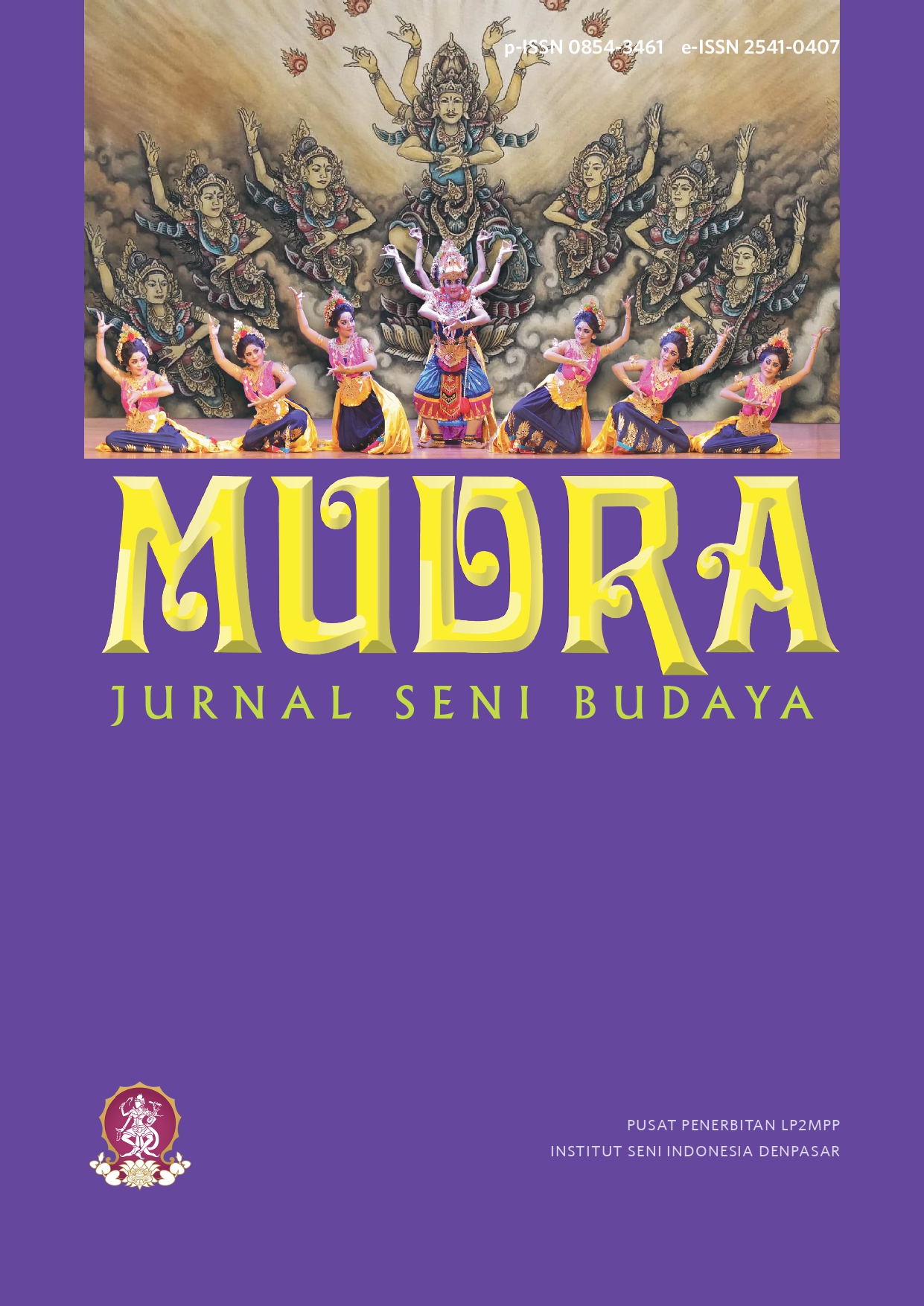Contemporary Textile Design Creation Sourced from Visual Aesthetics of Kawung Motif Classical Batik
DOI:
https://doi.org/10.31091/mudra.v39i4.1807Keywords:
motif, classical batik, textile design, contemporaryAbstract
The development of contemporary art and design is a dynamic reflection of social values, technological advancements, cultural shifts, and evidence of the ever-changing nature of human expression. However, local identities are often not visible, and many works of art and design seem stereotypical with similar appearances. Based on these conditions, it is necessary to conduct research on art creation by exploring local cultural values as an identity. This article describes the process of creating contemporary textile designs sourced from the visual aesthetics of classic batik Kawung motifs, which are full of aesthetic value. The art creation method is carried out by collecting information about the visual aesthetics of classic batik Kawung motifs, exploring ideas based on visual aesthetics in Kawung batik motifs, developing creation ideas through design experiments, and realizing textile designs into fabric prototypes. The results of this study include (1) analysis of basic ornaments of geometry, repetition patterns, and symmetrical compositions in Kawung classic batik motifs, (2) the process of embodiment of contemporary textile design with the concept of transformation geometry through rotation, reflection to create rhythm and composition, as well as translation and dilatation to find the artistic value of shapes, (3) descriptions of the form of contemporary textile design works that have been produced. The study results show that classic batik's aesthetic value is a potential source of ideas for creating contemporary textile designs. Through a formalistic study of Kawung classic batik motifs, a method of making ornaments with transformative geometry techniques was found as a guideline and formulation for creating contemporary textile designs. Local values in the Kawung motif, such as the pattern of rotation, reflection, rhythm, and recomposition of geometric shapes, are still relevant and contextual with the development of the times. Thus, it is essential to use it as a source of inspiration for creating contemporary textile designs with a strong identity.
Downloads
References
Anggraeni, M. K., Mardiyana, M., & Saputro, D. R. S. (2018). Geometric Transformation in Surakarta Batik Patterns. Proceedings of the Mathematics, Informatics, Science, and Education International Conference (MISEIC 2018), 157(Miseic), 93–95. https://doi.org/10.2991/miseic-18.2018.22
Araujo, A. (2010). Repetition, pattern, and the domestic: Notes on the relationship between pattern and home-making. Textile: The Journal of Cloth and Culture, 8(2), 180–201. https://doi.org/10.2752/175183510X12791896965574
Budi, S. (2017). Enam Motif Batik Klasik Dan Satu Lurik Dalam Sistem Nilai Ritual Mitoni Masyarakat Surakarta. In Disertasi, Yogyakarta: Program Pascasarjana Institut Seni Indonesia Yogyakarta.
Candy, L., & Edmonds, E. (2018). Practice-based research in the creative arts Foundations and Futures from the Front Line. LEONARDO, 51(2), 111–117. https://doi.org/10.1162/LEON
Christanti, A. D. I., Sari, F. Y., & Pramita, E. (2020). Etnomatematika Pada Batik Kawung Yogyakarta Dalam Transformasi Geometri. ProSANDIKA UNIKAL (Prosiding Seminar Nasional Pendidikan Matematika Universitas Pekalongan), 1, 435–444. https://proceeding.unikal.ac.id/index.php/sandika/article/view/438
Dallow, P. (2003). Representing creativeness : practice-based approaches to research in creative arts. Art, Design & Communication in Higher Education, 2(1), 49-66. https://doi.org/10.1386/adch.2.1.49/0
Ernawati, E., Margana, S., & Marianto, M. D. (2024). Re-actualization of Traditional Themes in Contemporary Craft Art through the Concept of Hybrid Aesthetics. International Journal of Current Science Research and Review, 07(04), 2090-2103.
https://doi.org/10.47191/ijcsrr/v7-i4-12
Harland, R. G. (2020). Graphic design studies: what can it be? Following in Victor Margolin’s footsteps for possible answers. DRS2020: Synergy, 2, 586–600. https://doi.org/10.21606/drs.2020.372
Ibrahim, B. M. (2017). An Investigation of Surface patterns, spatiality and pattern relations in textile design. IOSR Journal of Polymer and Textile Engineering (IOSR-JPTE), 8(2), 9–17. https://doi.org/10.9790/019X-08020917
Johnstone, T. K. (2017). Surface patterns, spatiality and pattern relations in textile design [University of Boras]. https://doi.org/10.1386/adch.2.1.49/0
Kakarla, D. U. (2024). The Evolution of Contemporary Art: A Journey Through Cultural Shifts. International Journal of Social Sciences and Humanities Invention, 11(04), 8119–8122. https://doi.org/10.18535/ijsshi/v11i04.02
Knight, T. W. (1998). Infinite Patterns and Their Symmetries. Leonardo, 31(4), 305–312. https://doi.org/https://doi.org/10.2307/1576670
Mitchell, D. (2014). Lattice Labyrinth Tessellations. Proceedings of Bridges 2014: Mathematics, Music, Art, Architecture, Culture, 211–218.
Muhadiyatiningsih, S. N., & Hikmawati, A. (2018). Motif Batik Tradisional Surakarta Tinjauan Makna Filosofis dan Nilai-nilai Islam. Al-Ulum, 18(2), 365–382. https://doi.org/10.30603/au.v18i2.499
Nurcahyanti, D., Sachari, A., & Destiarmand, A. H. (2020). Peran Kearifan Lokal Masyarakat Jawa Untuk Melestarikan Batik Tradisi di Girilayu, Karanganyar, Indonesia. Mudra Jurnal Seni Budaya, 35(2), 145–153. https://doi.org/10.31091/mudra.v35i2.816
Pangarsa, N. A., & Agustin, D. (2020). Optimisme Desain Untuk Pembangunan Negeri Aplikasi dan Eksplorasi Motif Ragam Hias Batik Kawung Serta Batik Parang Sebagai Upaya Pelestarian Batik Dalam Perancagan dalam Interrior. Prosiding SNADES 2020 - Optimisme Desain Untuk Pembangunan Negeri APLIKASI, 128–133.
Pradanti, P., & Sari, M. R. A. (2016). Geometri Transformasi Dalam Motif Batik Kawung Yogyakarta. Prosiding Seminar Nasional Matematika Dan Terapannya 2016, 357–370.
Takdir, M., & Hosnan, M. (2021). Revitalisasi Kesenian Batik sebagai Destinasi Wisata Berbasis Budaya dan Agama: Peran Generasi Muda dalam Mempromosikan Kesenian Batik di Pamekasan Madura. Mudra Jurnal Seni Budaya, 36(3), 366–374. https://doi.org/10.31091/mudra.v36i3.1284
Wahida, A., Handayani, E. S., & Fuad, F. R. (2018). Aesthetic Values of Classical Batik as the Source of Contemporary Painting Ideas. In Proceedings of the 4th Bandung Creative Movement International Conference on Creative Industries 2017 (4th BCM 2017). Atlantis Press. https://doi.org/10.2991/bcm-17.2018.22
Wahida, A., Handayani, E. S., & Supriyadi, S. (2020). The Philosophical Values of Kawung Batik Motif in Contemporary Batik Painting. Mudra Jurnal Seni Budaya, 35(1), 76–82. https://doi.org/10.31091/mudra.v35i1.1001
Downloads
Published
How to Cite
Issue
Section
License
Copyright (c) 2024 Adam Wahida, M. Hendra Himawan

This work is licensed under a Creative Commons Attribution-NonCommercial-ShareAlike 4.0 International License.
- Copyright on any open access article in a journal published by Mudra Jurnal Seni Budaya is retained by the author(s).
-
The Creative Commons Attribution License 4.0 formalizes these and other terms and conditions of publishing articles.









